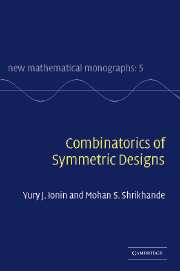Book contents
- Frontmatter
- Contents
- Preface
- 1 Combinatorics of finite sets
- 2 Introduction to designs
- 3 Vector spaces over finite fields
- 4 Hadamard matrices
- 5 Resolvable designs
- 6 Symmetric designs and t-designs
- 7 Symmetric designs and regular graphs
- 8 Block intersection structure of designs
- 9 Difference sets
- 10 Balanced generalized weighing matrices
- 11 Decomposable symmetric designs
- 12 Subdesigns of symmetric designs
- 13 Non-embeddable quasi-residual designs
- 14 Ryser designs
- Appendix
- References
- Index
3 - Vector spaces over finite fields
Published online by Cambridge University Press: 26 February 2010
- Frontmatter
- Contents
- Preface
- 1 Combinatorics of finite sets
- 2 Introduction to designs
- 3 Vector spaces over finite fields
- 4 Hadamard matrices
- 5 Resolvable designs
- 6 Symmetric designs and t-designs
- 7 Symmetric designs and regular graphs
- 8 Block intersection structure of designs
- 9 Difference sets
- 10 Balanced generalized weighing matrices
- 11 Decomposable symmetric designs
- 12 Subdesigns of symmetric designs
- 13 Non-embeddable quasi-residual designs
- 14 Ryser designs
- Appendix
- References
- Index
Summary
Prototypes of many combinatorial designs come from finite projective geometries and finite affine geometries. Vector spaces over finite fields provide a natural setting for describing these geometries. Among the numerous incidence structures that can be constructed using affine and projective geometries are infinite families of symmetric designs, nets and Latin squares. Subspaces of a vector space over a finite field can be regarded as linear codes that will be used in later chapters for constructing other combinatorial structures, such as Witt designs and balanced generalized weighing matrices.
Finite fields
In this section we recall a few basic results on finite fields which will be used throughout this book.
For any prime p, the residue classes modulo p with the usual addition and multiplication form a finite field GF(p) of order p. These fields are called prime fields. Any finite field F of characteristic p contains GF(p) as a subfield. The field F then can be regarded as a finite-dimensional vector space over GF(p), and therefore, |F| = pn where n is the dimension of this vector space. Conversely, for any prime power q = pn, there is a unique (up to isomorphism) finite field of order q. This field is denoted by GF(q) and is often called the Galois field of order q. In general, the field GF(q) is isomorphic to (a unique) subfield of the field GF(r) if and only if r is a power of q.
- Type
- Chapter
- Information
- Combinatorics of Symmetric Designs , pp. 59 - 112Publisher: Cambridge University PressPrint publication year: 2006



